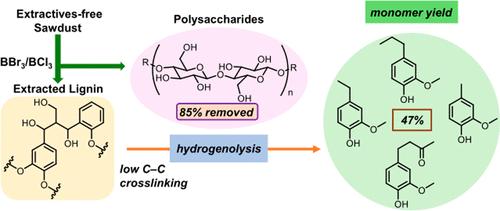当前位置:
X-MOL 学术
›
ACS Sustain. Chem. Eng.
›
论文详情
Our official English website, www.x-mol.net, welcomes your
feedback! (Note: you will need to create a separate account there.)
Boron Lewis Acid Extraction of Wood Generates High Quality Lignin
ACS Sustainable Chemistry & Engineering ( IF 7.1 ) Pub Date : 2024-11-14 , DOI: 10.1021/acssuschemeng.4c06206 Theodora E. Leventis, Patrick Judge, Jialiang Zhang, M. Zain H. Kazmi, Marcus B. Foston, Florence J. Williams
ACS Sustainable Chemistry & Engineering ( IF 7.1 ) Pub Date : 2024-11-14 , DOI: 10.1021/acssuschemeng.4c06206 Theodora E. Leventis, Patrick Judge, Jialiang Zhang, M. Zain H. Kazmi, Marcus B. Foston, Florence J. Williams

|
The separation of lignocellulose into lignin, cellulose, and hemicellulose without significantly altering the chemical structures of these component biopolymers remains a modern chemical challenge. Lignin, in particular, has potential as a highly valuable feedstock material but remains underutilized due to the difficulty of generating lignin with low modification and condensation. This work investigates the lignin-rich solids (“boron lignin”) generated from a previously reported boron Lewis acid-mediated lignocellulose separation and concludes that (1) boron Lewis acid extraction removes 80–85% of carbohydrates from the original lignocellulose sample, and (2) the resulting lignin possesses a low condensation level and high similarity to native lignin structure. Residual carbohydrate assessment, depolymerization efficiency analyses, heteronuclear single quantum coherence (HSQC) and solid-state nuclear magnetic resonance (NMR) analyses are discussed, including benchmarking results with alternate lignin sources known to possess low and high condensation levels. Further, two different wood sources (white pine, a softwood, and beechwood, a hardwood) were employed to generate lignin samples. Depolymerization of a white pine-derived boron-lignin produced 47% (±9.5) of extractable monomers, which compares well to a state-of-the-art method to generate low condensed lignin (56 ± 7.8%). An unexpected instability of the oil sample was observed following hydrogenolysis of boron lignin generated from beechwood. Dramatic color changes coupled with precipitation and lowered monomer yields were observed when samples were aged (11% decrease) or concentrated (30% decrease). Based on NMR spectroscopic analyses, this instability is postulated to arise due to boron-mediated demethylation of methoxy sites on the lignin scaffold.
中文翻译:

木材的硼路易斯酸萃取可产生高质量的木质素
在不显著改变这些成分生物聚合物的化学结构的情况下,将木质纤维素分离成木质素、纤维素和半纤维素仍然是一项现代化学挑战。特别是木质素,具有作为高价值原料的潜力,但由于难以生成低改性和低缩合的木质素,因此仍未得到充分利用。这项工作研究了先前报道的硼路易斯酸介导的木质素纤维素分离产生的富含木质素的固体(“硼木质素”),并得出结论:(1) 硼路易斯酸萃取从原始木质素纤维素样品中去除了 80-85% 的碳水化合物,以及 (2) 所得木质素具有低缩合水平和与天然木质素结构的高度相似性。讨论了残余碳水化合物评估、解聚效率分析、异核单量子相干 (HSQC) 和固态核磁共振 (NMR) 分析,包括使用已知具有低冷凝水平和高冷凝水平的替代木质素源的基准测试结果。此外,采用两种不同的木材来源(白松,一种软木和山毛榉木,一种硬木)来生成木质素样品。白松衍生的硼木质素的解聚产生了 47% (±9.5) 的可萃取单体,这与生成低缩合木质素 (56 ± 7.8%) 的最先进方法相比很好。在山毛榉木生成的硼木质素加氢后观察到油样的意外不稳定。当样品老化(减少 11%)或浓缩(减少 30%)时,观察到显著的颜色变化加上沉淀和单体产量降低。 根据 NMR 波谱分析,这种不稳定性被认为是由于硼介导的木质素支架上甲氧基位点的去甲基化而引起的。
更新日期:2024-11-14
中文翻译:

木材的硼路易斯酸萃取可产生高质量的木质素
在不显著改变这些成分生物聚合物的化学结构的情况下,将木质纤维素分离成木质素、纤维素和半纤维素仍然是一项现代化学挑战。特别是木质素,具有作为高价值原料的潜力,但由于难以生成低改性和低缩合的木质素,因此仍未得到充分利用。这项工作研究了先前报道的硼路易斯酸介导的木质素纤维素分离产生的富含木质素的固体(“硼木质素”),并得出结论:(1) 硼路易斯酸萃取从原始木质素纤维素样品中去除了 80-85% 的碳水化合物,以及 (2) 所得木质素具有低缩合水平和与天然木质素结构的高度相似性。讨论了残余碳水化合物评估、解聚效率分析、异核单量子相干 (HSQC) 和固态核磁共振 (NMR) 分析,包括使用已知具有低冷凝水平和高冷凝水平的替代木质素源的基准测试结果。此外,采用两种不同的木材来源(白松,一种软木和山毛榉木,一种硬木)来生成木质素样品。白松衍生的硼木质素的解聚产生了 47% (±9.5) 的可萃取单体,这与生成低缩合木质素 (56 ± 7.8%) 的最先进方法相比很好。在山毛榉木生成的硼木质素加氢后观察到油样的意外不稳定。当样品老化(减少 11%)或浓缩(减少 30%)时,观察到显著的颜色变化加上沉淀和单体产量降低。 根据 NMR 波谱分析,这种不稳定性被认为是由于硼介导的木质素支架上甲氧基位点的去甲基化而引起的。


















































 京公网安备 11010802027423号
京公网安备 11010802027423号